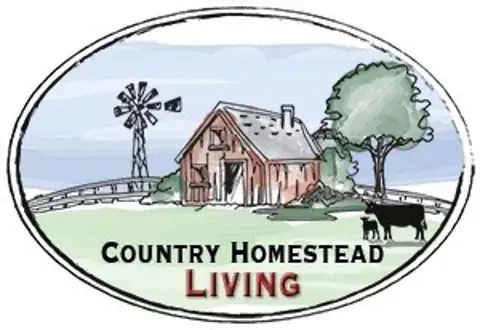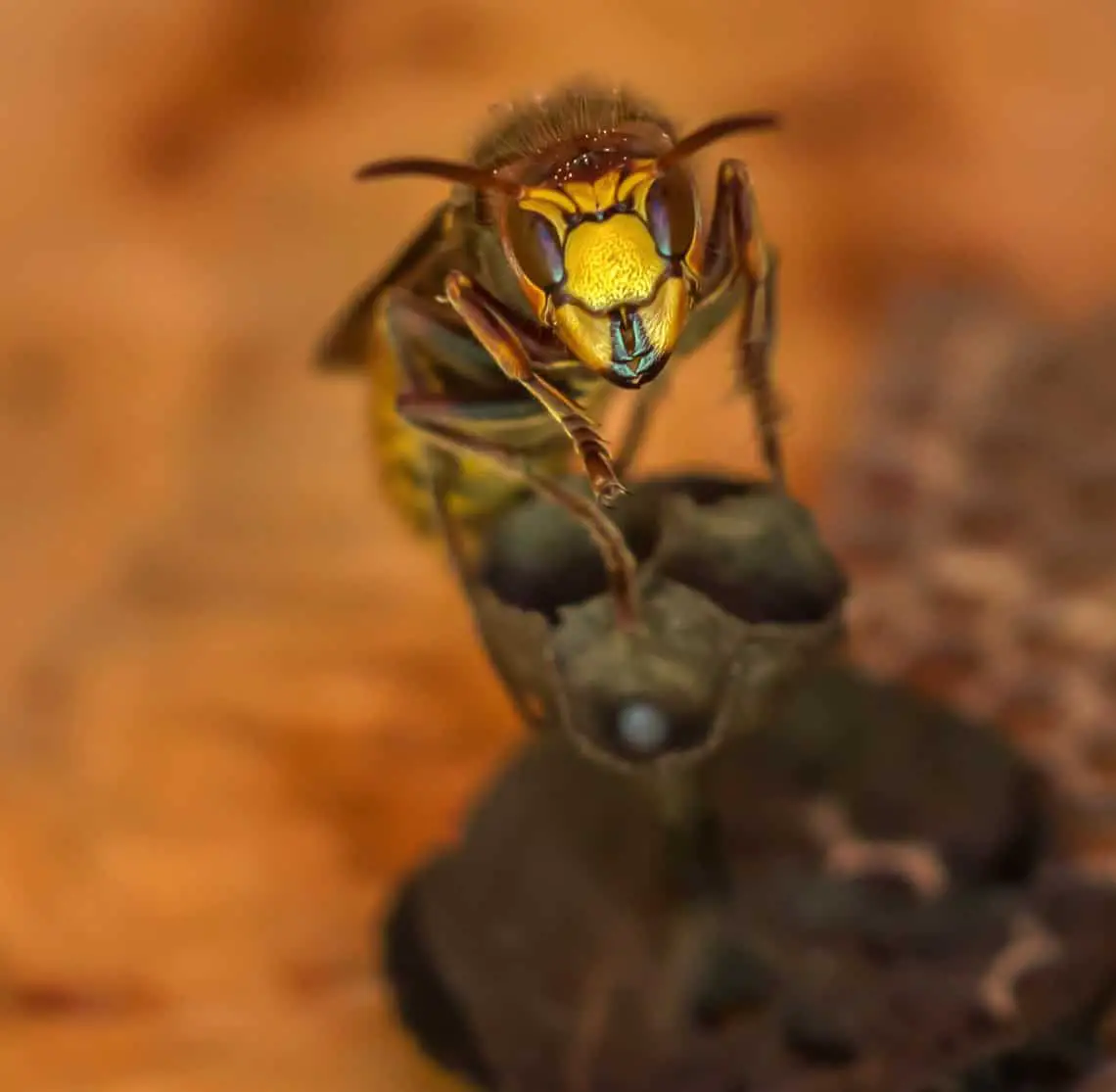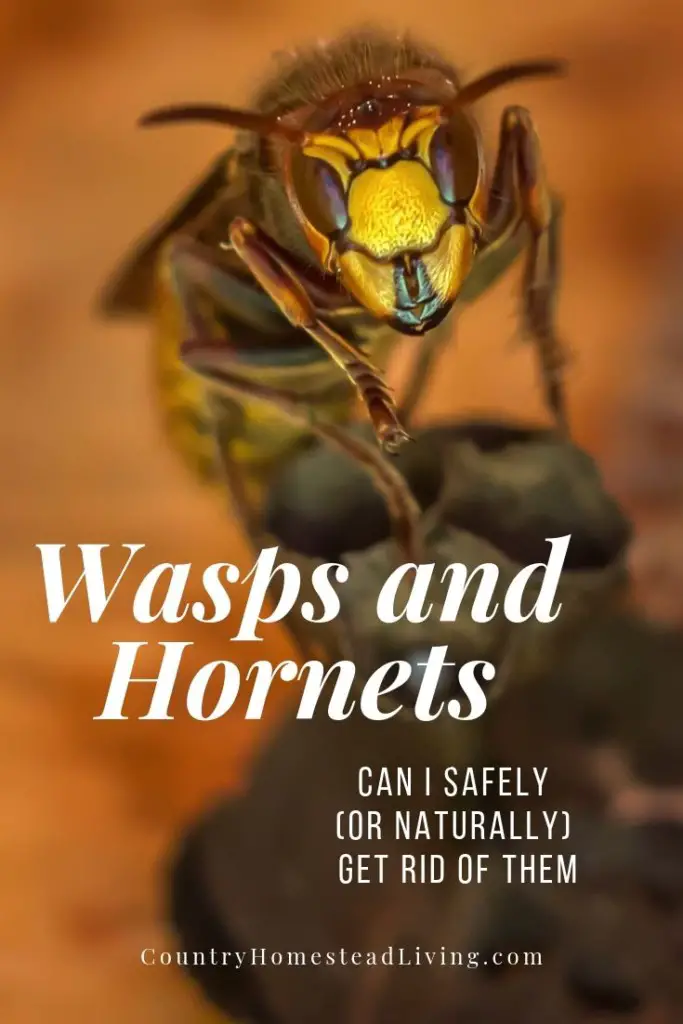I have been stung by Wasps and Hornets many times in my lifetime. I would wager that you also have been stung a few times too.
This experience reinforces the fact that you need to know how to safely (or naturally) rid your homestead of Wasps and Hornets.
Drawing from my training in Pest Control Management and some 10 years of experience dealing with pests, I’d like to share what I have acquired a knowledge of.
Can you safely (or naturally) get rid of Wasps and Hornets?
Yes, you can safely or naturally get rid of Wasps and Hornets using the simple and reliable methods outlined here.
I provide details about the best natural or safe methods and the best time of day to use them.
- Identification of flying stinging pests
- Characteristics of Wasps, Hornets, and Yellow Jackets
- Non-toxic formulations to use
- Safest chemical formulations to use in some instances
- Determining when to use them
- Simple traps that are both safe and effective
- When to remove and dispose of Wasp and Hornet nests.
Identifying Flying, Stinging Pests
Wasps
Wasps are usually about 3/4 – 1 inch long. They are social creatures that build nests of paper like material that is made from wood fibers and salivary secretions of the female workers.
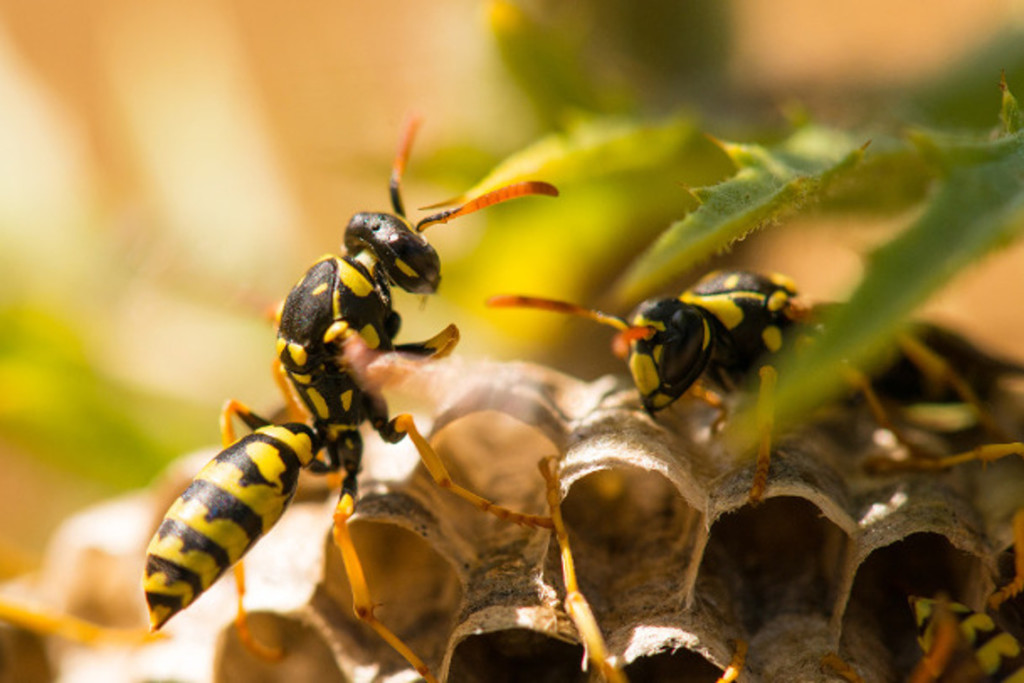
In temperate northern regions of the world, new colonies must be founded every year due to the fact that only mated queens from the previous year live through the winter.
These mated queens hide in protected places under tree bark, attics and other sheltered places.
Those queens that survive the winter will emerge from their hiding place and start building a small nest and lay a few eggs in it.
She will forage for food for the developing larvae until there are female workers to take over the nest building, foraging for food and caring for larvae. When that time comes the queen’s sole job is to lay eggs.
Wasp larvae feed on proteins such as caterpillars and bodies of other insects.
Adult Wasps feed on liquids such as nectar, honey dew and juices from bodies fed to larvae. They also feed on ripe or nearly ripe fruits encountered during foraging.
Wasps can be found feeding on strawberries, raspberries, blueberries and blackberries and rarely is the entire berry eaten. Thus they can contribute to a loss of fruit production on the homestead.
A common Wasp is called the Paper Wasp because of the simple single layer paper appearing nests they build. These nests hang down and are composed of cells that open downward.
Paper Wasp nests can be found hanging from eaves of houses and beneath window ledges or porch roofs.
These nests can be up to 6 – 8 inches in diameter. There can be 100 – 200 workers on a Paper Wasp nest at one time.
Hornets

Hornets are flying stinging pests that can be up to 1.5 inches in length.
Hornets are social creatures that build large grayish brown carton structures that resemble inverted teardrops or bloated soccer balls.
Hornets are probably the most feared of all stinging pests.
Their nest has a single opening in the bottom of the inverted teardrop. Some may even have new Paper Wasp like structures built on the side of the nest.
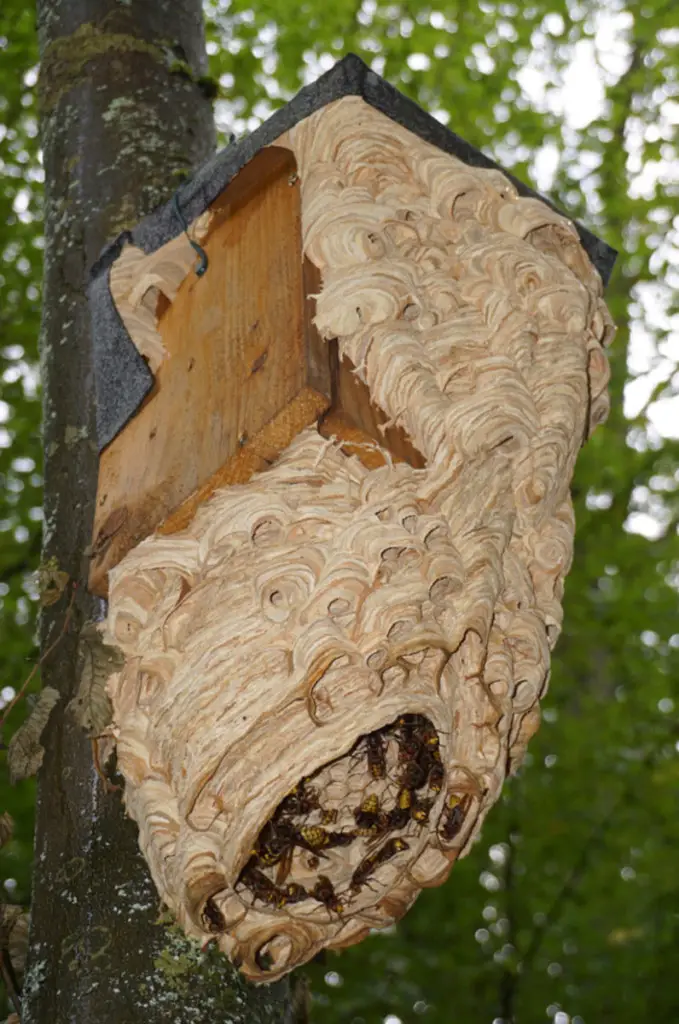
Like Wasps, only the queens overwinter and start new colonies the next year in temperate northern regions of the world.
A common Hornet is the Bald-faced Hornet that has yellowish markings between the eyes and a black body with white markings on the thorax and abdomen.
Yellow Jackets
Yellow Jackets are the smallest of the common dangerous, stinging, flying pests.
Yellow Jackets are about 1/2 inch long. They have dark bodies with rings of yellow going around the abdomen.
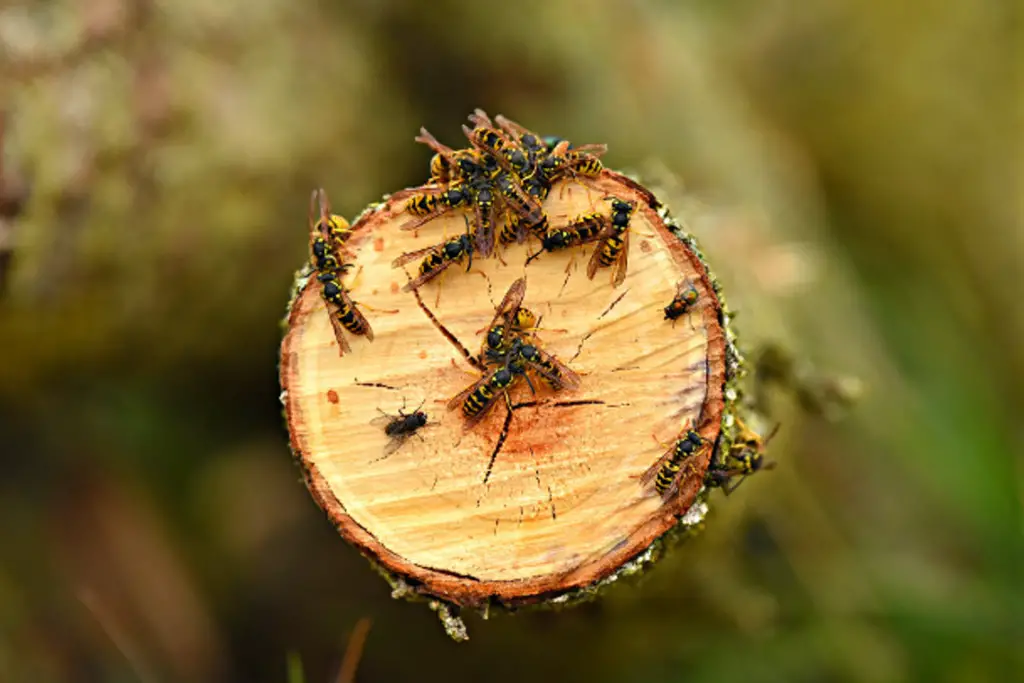
Yellow Jackets normally nest underground. Excessive wetness and rains in early spring is thought to decrease colony survival of these stinging pests.
Some Yellow Jacket nests are started in old abandoned mammal burrows underground.
Some Yellow Jacket colonies can be found nesting in concrete blocks of building foundations.
Another place they may nest is underneath railroad ties used in landscaping around patios.
The German Yellow Jacket is a species that has spread across much of the U.S.
They often nest in wall voids, attics or crawlspaces, anyplace where they find a hole or crack in the exterior of a building to use as their entry.
All Yellow Jacket nests are made like the Hornet nests even though underground or within an existing structure.
Yellow Jackets can produce several thousand workers in a single season.
And in some parts of Florida and California Yellow Jackets can live and produce from a single colony for more than a year.
Some Yellow Jacket species forage for flies, caterpillars and other insects.
Other species forage for meat from carcasses, garbage and picnic tables to feed their developing larvae.
All Yellow Jackets are attracted to sugars or other carbohydrates such as beer, fruit, especially sliced watermelon and soft drinks at picnic sites and patio cookouts.
In late summer the competition for food sources can become acute. This can put Yellow Jackets and human food sources at picnics and patios in very close association.
More than one human has taken a drink out of a pop can and been stung by a Yellow Jacket that crawled inside the can to get her share of pop!
Yellow Jacket workers can be unpredictable when it comes to stinging unsuspecting humans.
Many times a human just walking near an underground nest is ignored Other times one walking nearby receives multiple stings.
Most stinging happens when the nest is disturbed accidentally by walking across the top of it jarring the underground structure.
Yellow Jacket venom has caused more life-threatening reactions in stinging victims than the venom of Wasps and Hornets.
Yellow Jackets are sensitive to cold temperatures but it takes at least 5 – 7 days of temperatures below 45 degrees F (7.2 degrees C) to kill a colony.
Similarities Between Wasps, Hornets And Yellow Jackets
Wasps, Hornets and Yellow Jackets are social, flying, stinging pests. It is only the females who have stingers.
Unlike Honey Bees, Wasps, Hornets and Yellow Jackets can remove their stingers and sting you again.
When a Wasp, Hornet or Yellow Jacket is killed it’s body gives off a chemical signal that causes others to attack. So if you do not do a good job of spraying a nest you will probably get stung more than once.
Contrary to popular belief, Windex does not always kill flying, stinging pests!
If you try using Windex, you may be setting yourself up to get stung by provoking an attack.
Differentiating Between Honey Bees And Wasps, Hornets And Yellow Jackets
Wasps, Hornets and Yellow Jackets have smooth, shiny bodies devoid of hair.
Honey Bees have tiny hairs on their bodies which aid in the pollination of plants.
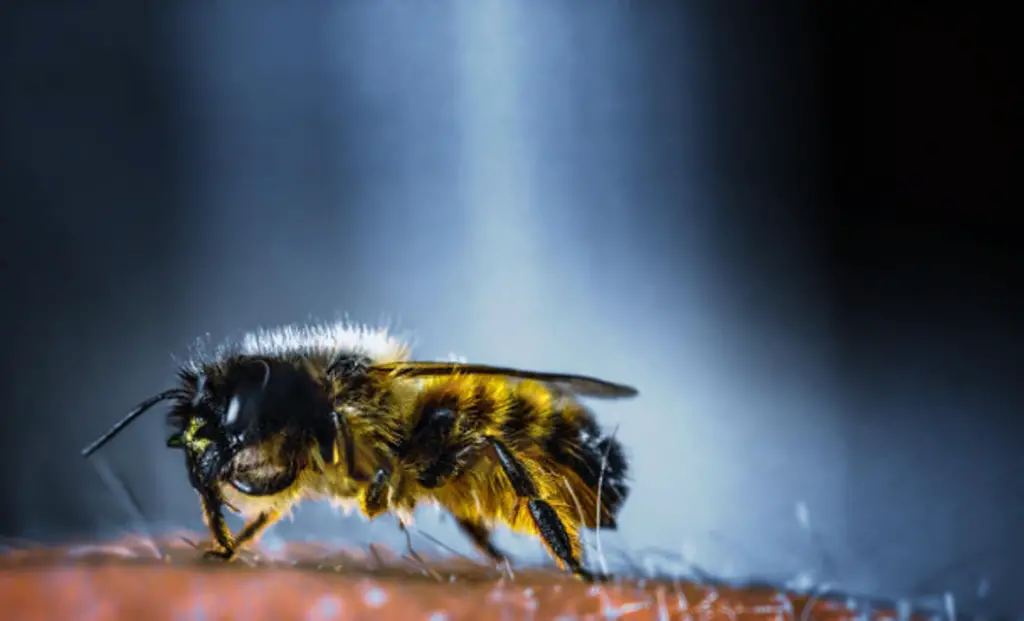
If you find a Bee like insect in a flower, it is probably a Honey Bee and not a Wasp, Hornet or Yellow Jacket.
Another difference is that Bees have rounded bodies that are made up of only one section.
Wasps, Hornets and Yellow Jackets however have a slender body that tapers to a waist that connects their thorax to their abdomen.
A Honey Bee can only sting once and then it dies.
Wasps, Hornets and Yellow Jackets can sting multiple times without dying.
Non-toxic Formulations That Kill Wasps And Hornets
Pests such as Wasps, Hornets and Yellow Jackets breathe through breathing tubes in their body covering.
When sprayed with a substance that coats their body they suffocate. Additionally, some types of natural sprays also render their wings useless.
Caution: The formulations that kill Wasps, Hornets and Yellow Jackets will also kill Honey Bees.
Always use caution to determine whether it is a Honey Bee or some other flying, stinging pest!
Some of the substances that can coat Wasps, Hornets and Yellow Jackets and suffocate them include:
- Liquid dish washing soap such as Dawn
- White vinegar
- Bleach
- WD-40
- Hair Spray
Most non-toxic formulations will consist of liquid dish washing soap, white vinegar or bleach.
And there may be added liquid Peppermint Extract or Peppermint Essential Oil which both potentiates and repels these flying, stinging pests.
WD-40 and Hair Spray are not good substitutes for killing flying, stinging pests because the spray may not cover enough of their body to prevent them from getting through and stinging you before they die.
Hair Spray can have a finer mist type spray and WD-40 may have a stream type spray that can be avoided by Wasps, Hornets and Yellow Jackets.
An equal mixture of bleach and water in a spray bottle can easily kill flying, stinging pests.
But it’s best to know where you are spraying as the bleach can discolor some surfaces.
Natural Wasp Spray Formula 1
In a spray bottle mix:
- 1/4 – 1/2 cup of liquid dish washing soap per cup of water
- Add 20 drops of liquid peppermint Extract or Peppermint Essential oil (link to read reviews on Amazon)
This is a good spray to use on single Wasps, Hornets or Yellow Jackets that you find flying inside or around plants in the garden or green house.
Take care that you do not confuse Honey Bees for Wasps!
Natural Wasp Spray Formula 2
In a spray bottle mix:
- 1 cup white vinegar
- 1 cup water
This mixture will also kill flying, stinging pests found inside the house, green house or garden.
Observe the same precaution against killing Honey Bees.
Natural Wasp Nest Spray Formula
In a spray bottle mix:
- Equal parts of white vinegar and water
- One to two tablespoons liquid dish washing soap per cup of solution
- One to two teaspoons liquid Peppermint Oil or Peppermint Essential Oil (link to read reviews on Amazon) per cup of solution
The best time to use this formula on a nest of flying, stinging pests is when they are least active.
This is normally around sunrise, at dusk or on a cool early morning when they are lethargic due to the cool temperature.
Unless you make this mixture in a large garden sprayer, such as a 1 gallon size that has a pump to pressurize it as well as a hose with a nozzle and a trigger with which to activate the spray, you will have to get very close to the nest to spray it.
Use extreme caution if on a ladder or on a roof and spraying a nest!
Do not do this unless you have on gloves, a long sleeved shirt and long pants and there is no way these flying stinging insects can get inside your clothes!
You will also want a hat and at least goggles to protect your eyes.
A sting when on a ladder or roof could result in your falling off that ladder or roof and sustaining a serious injury!
The best personal protection is to wear a Wasp Suit or a Bee Suit.
If you are allergic to Wasp, Hornet or Yellow Jacket venom, DO NOT attempt to spray a nest!
Getting a professional to spray the nest for you is much cheaper and safer than risking a serious reaction or death from stings!
Best Time To Spray A Nest
The best time to spray a nest is when the nest is small and there are only 2 or 3 flying, stinging pests to come after you.
The Natural Wasp Nest Spray Formula can kill the flying, stinging pests on contact
But there is always the chance of one or two avoiding the spray and coming for you.
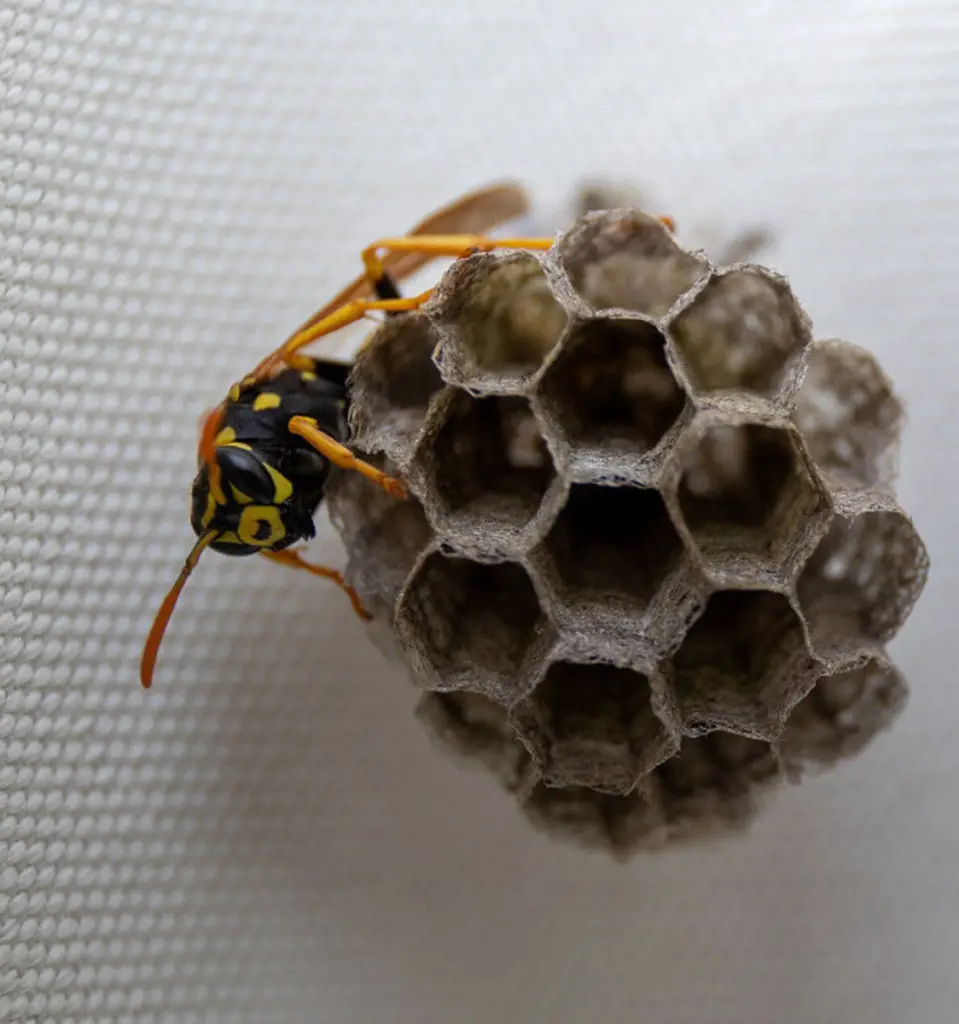
My personal preference for spraying a nest is on a cool morning when the temperature is in the 50’s F.
Wasps and hornets are very lethargic at that temperature and you have a much greater chance of getting all of them with the spray.
On our homestead, my wife looks for the nests that need to be sprayed and points them out to me.
Then I do the spraying early on a cool morning when the chances of getting stung are minimal. You might call this a “Search and Destroy Mission.”
Spraying Wasp Nests
Would I attempt to spray a 6 To 8 inch in diameter Wasp nest with a lot of Wasps on it?
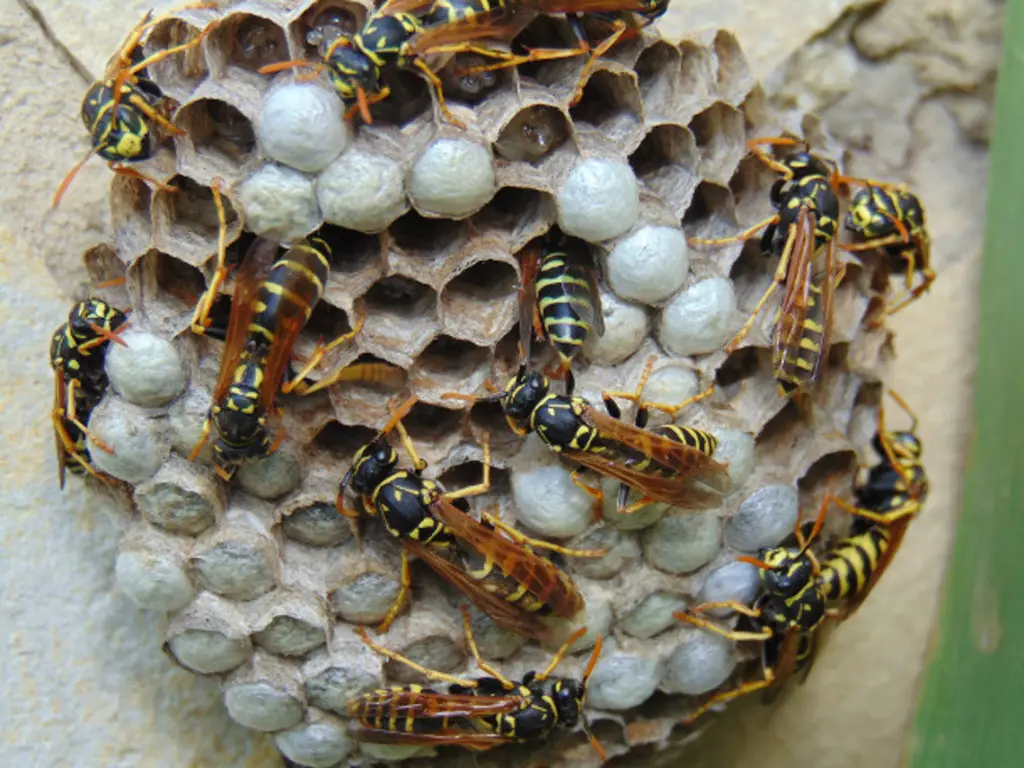
The answer depends on whether I am using the Natural Wasp Nest Spray Formula or a commercial foam Wasp and Hornet Spray.
There is a reason for wanting to spray a nest that is very small and only has 2 or 3 flying, stinging insects on it. There is less chance of getting stung.
It takes less Natural Wasp Nest Spray to achieve a 100% elimination of the flying stinging pests when the nest is small.
There is also less chance of you falling off a roof or ladder if the target area and number of flying, stinging pests is small.
Even though the Natural Wasp Nest Spray is very effective it does not cover and smother the nest like commercial Wasp and Hornet Spray Foam does.
This means that there is a greater chance of stings and falls and serious injury if the nest is large with lots of those flying, stinging pests to come after you when trying to spray a large nest with the Natural Wasp Nest Spray Formula.
In my two medically related professions I learned about something called “risks and benefits”. There are times they are a real balancing act.
In balancing the risks and benefits of spraying a large nest with a lot of flying, stinging pests the risk benefit analysis goes like this:
- The risks of stings and injury from falls off of a ladder or roof go up in proportion to the size of the nest and the number of flying, stinging pests on the nest. Even if you attack the nest at the best possible time and temperature of the day
- The Natural Wasp Nest Spray is less toxic to the homestead
- The chances of injury from a fall are increased the higher the nest to be sprayed is above the ground
- If the nest is high on the house or if you have to get on the roof to spray the nest the chances of a sting causing a fall and injury go way down if a commercial Wasp and Hornet Foam Spray is used
- All commercial foam sprays have a residual effect plus a toxicity greater than the Natural Wasp Nest Spray has
- You can be further from the nest and get a better result from using the commercial foam spray than you can get with a one gallon pump sprayer and the natural Wasp Nest Spray
So weighing all the risks and benefits for any given nest site gives you the answer you need for that specific nest that needs to be sprayed.
There are times I use the commercial Spectricide Wasp and Hornet Foam Spray (link to read reviews on Amazon) because it sprays up to 27 feet.
The potential risks are offset by the additional safety margin from a fall and injury when spraying that particular nest.
On our homestead a fall and a broken arm or leg could mean a missed harvest or too little firewood being harvested for winter.
Using safety margins could mean a large hospital bill that would be avoided if the potential for a fall and injury was lessened as much as possible.
Getting Rid Of A Hornet’s Nest
Like getting rid of a Wasp’s nest, getting rid of a Hornet’s nest is easier if the nest is small and there are fewer Hornets to deal with.
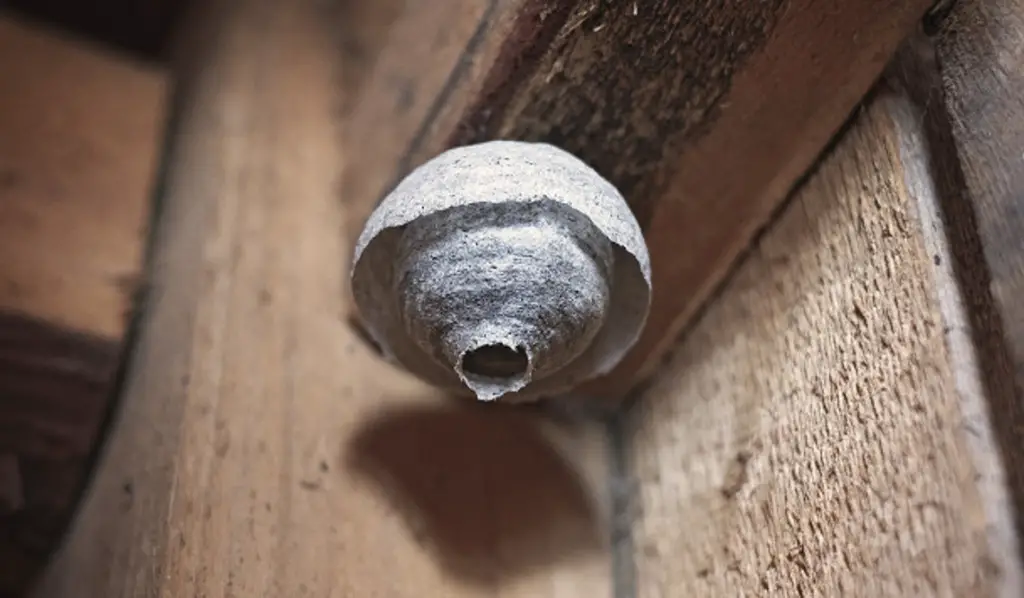
Spray the nest directing the spray upward through the hole in the bottom of the nest.
Then smash the nest with a suitable piece of wood such as a 2 X 4.
This is the way to do it if the nest is only a couple of inches in size and the early morning temperature is in the 50’s F.
This is NOT the way to do it if the nest is larger than about 2 inches in size!
The larger the nest, the greater the chance of stings because there are more Hornets defending the nest.
What ever you do, DO NOT try to destroy a large nest using a stream of water from a garden hose!
Using a stream of water from a garden hose will only make the Hornets very angry when the nest is torn apart by the force of the water.
Hornets are not killed by getting them wet with water, they are only angered!
Getting rid of a large Hornet nest involves more risk than getting rid of a large wasp nest because a large Hornet nest can hold a thousand Hornets.
If the Hornet’s nest is large, say hanging down 8 or 10 inches from its attachment, you should not attempt to get rid of it unless you are properly suited up for the task.

You should probably be in a complete Wasp Suit or Bee Keepers suit with the net from a hat around your head and face.
And all clothing openings should be covered or tight enough to prevent an angry hornet from getting inside.
A Wasp Suit (link to read reviews on Amazon) is made of heavier material than a Bee Suit (link to read reviews on Amazon) so there is more protection from stings from Hornets which are larger stinging pests than Honey Bees.
If a Wasp Suit can not be found, wear a Bee Suit with two layers of clothing under it to give thicker protection against Hornet Stings.
When removing a Hornet’s nest, eye protection is needed under the netting surrounding your face and head.
Bald Faced Hornets can spray venom through the netting into your eyes. So wear glasses or goggles for protection when removing a Hornet’s nest or spraying Hornets.
You should also wear thick sting proof gloves (link to read reviews on Amazon) on your hands.
Then on a cool morning, in the 50’s F, use a heavy duty black plastic garbage bag, (link to read reviews on Amazon) the type with ties that would completely seal off the opening with one pull.
Carefully slip the plastic trash bag completely over the entire Hornet’s nest and quickly pull the ties to completely shut off the mouth of the bag.
Securely tie the bag closed as you pull on the bag removing the Hornet’s nest from it’s attachment.
Be sure there are no holes in the plastic trash bag. Make sure it is “heavy duty.”
Then place the bag where it will not get punctured but can lay in the hot sun which will cook the hornets to a crisp.
A black trash bag that is at least 1.05 mil thick with ties is best.
An alternative is to place the bag of Hornets and nest into a freezer for 24 hours to kill them.
The method I prefer is to tie a cloth bag around the nest and placing it in a bucket of water, putting a rock on top of it to keep the bag of hornets under water until they drown.
I am likewise reluctant to try and spray up inside a large Hornet’s nest with a pump sprayer and the Natural Wasp Nest Spray.
If your aim is a little off and the Hornet Nest splits open you have hundreds of angry Hornets to deal with!
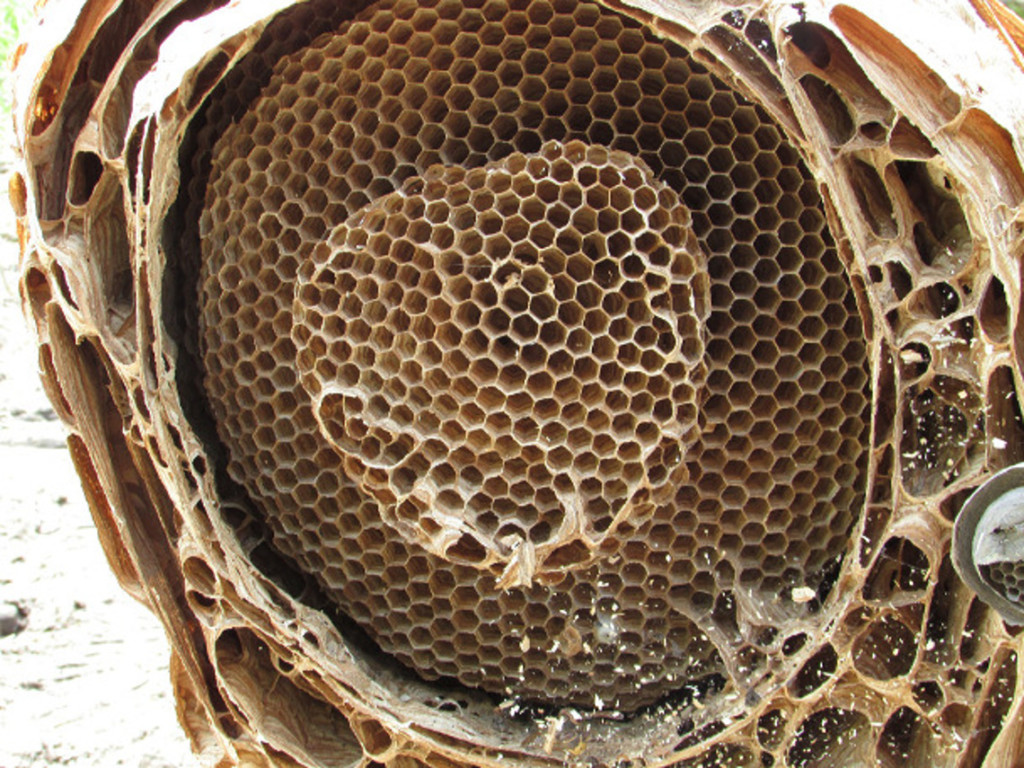
I have seen articles where Wasp and Hornet Spray Foam has been used to neutralize a large hornet’s nest.
The foam was first sprayed around the top of the nest where it attaches to a roof or tree limb. Then it was sprayed up inside through the hole in the bottom of the nest.
Before trying to do this method, you want to have at least 2 brand new cans of spray with the lids off ready and waiting.
You should also be all dressed out in a complete Wasp Suit or Bee Keeper’s Suit with all openings taped so no Hornets can get inside the suit.
Using commercial foam spray is not using a non-toxic method.
However, it could be necessary in some instances such as the Hornet’s nest several feet above the ground and not safe to try slipping a plastic trash bag over it as described above.
You might want to use the above “risk benefit analysis” in this case also.
Eliminating An Underground Yellow Jacket Nest
First, to eliminate an underground Yellow Jacket nest, the entrance needs to be located.
Many times locating a Yellow Jacket nest is accomplished, accidentally, when the angry Yellow Jackets come flying out to deal with what they perceive as a threat to their nest.
Mark the entrance in some way for easy and precise location in the evening or at night.
Although the nest can be taken care of in the daytime, there are less safety concerns when dealt with at night.
Before approaching the nest opening, have a flashlight or spotlight focused on the opening from a distance and off to one side from where the approach is made.
Do not hold the flashlight in your hand!
Any Yellow Jackets that might escape the entrance will head for the light!
It is best to wear a complete Wasp Suit or Bee Suit and to approach the opening slowly and cautiously.
Some articles advise using the Natural Wasp Nest Spray from a sprayer by placing the hose of the one gallon sprayer inside the opening and spraying away.
This method may work but it can also result in angry Yellow Jackets exiting the entrance to deal with you, the intruder.
Any spraying should be done with a piece of rag or steel wool being held over the entrance hole in the other hand to prevent Yellow Jacket’s from flying out of the nest.
As the spray nozzle is being removed, the rag or steel wool should be used to immediately plug the hole trapping the Yellow Jackets in their nest.
Now lets talk about what to use to get rid of the underground Yellow Jackets.
An underground nest will likely have more moisture or humidity due to being underground and cooler than a nest in a tree or on a wall. This can affect what is used to eliminate the Yellow Jackets.
Choice Of Yellow Jacket Poisons
For underground Yellow Jacket nests there are 3 natural poisons and 1 chemical poison to be considered.
Natural Poisons For Underground Yellow Jackets
- Natural Wasp Spray is effective against Yellow Jackets but there can be problems if the nest is located higher than the lowest point in the entrance to the nest. You would have to literally fill up the nesting cavity to assure you got rid of all the Yellow Jackets.
- Boric Acid (link to read reviews on Amazon) has been suggested in some articles on the internet. Boric Acid is a slow acting stomach poison that has to be ingested or is best picked up by the insects body as a dry residue. It takes a few days for insects to die when Boric Acid is used. Although it could work, the potential for increased moisture lessens the chances of success.
- Diatomaceous Earth (DE) (link to read reviews on Amazon) disrupts the hard waxy layer of an insects body causing them to slowly die of desiccation. But DE must remain dry in order to work and if the underground nest has enough moisture the DE will not work.
If you choose to try either Boric Acid or Diatomaceous Earth, they can be inserted into the underground nest by using a Duster.
Insert the tapered end of the Duster into the entrance and give several large puffs of the Boric Acid or DE.
At least 3 to 4 tablespoons of Boric Acid or DE should be placed into the opening.
As with the spray method, there should be a rag or piece of steel wool held in the other hand in such a way as to keep the Yellow Jackets from flying out of the nest while using the Duster.
As the tip of the Duster is removed, the hole is immediately plugged with the rag or steel wool to keep the Yellow Jackets in the nest.
Then puff several puffs of Boric Acid or DE around the entrance to get any workers who might try to return to the nest in the morning.
Leave the rag or steel wool plug in the entrance for at least 3 days. Then while wearing the Bee Suit, carefully remove the plug and see if any live Yellow Jackets come out of the nest.
With the natural methods it is likely that you will have to give more than one treatment to get rid of all the underground Yellow Jackets.
Chemical Poisoning For Underground Yellow Jackets
A sure way to get rid of underground Yellow Jackets involves the use of Sevin 5 Ready-To-Use 5% Dust.
When used properly this method is safe to be used on the homestead where there are both plants and animals that need to be to taken into consideration.
Sevin 5 has a Warning designation on the label which means it has a low to moderate toxicity to humans and other mammals.
When used in the manner described below, Sevin 5 is a safe and effective method for getting rid of underground Yellow Jackets.
There are 2 different Sevin formulations on the market today.
They are very different chemicals and different types of formulations.
Only the Sevin 5 has a dust formulation.
The other Sevin formulations are liquid sprays and granules. These are not the best formulations to use for ridding underground Yellow Jacket nests.
Both formulations are effective against Yellow Jackets and also toxic to Honey Bees and Bumble Bees which are very beneficial to homesteads, gardens and orchards.
However, only one of the formulations is best suited for getting rid of underground Yellow Jackets and that is the Sevin 5 Dust Bug Killer (link to read reviews on Amazon).
The Sevin 5 dust formulation is perfect for use in underground Yellow Jacket nests because it can reach both up into the nest and coat around the inside of the entrance in a manner that is effective in getting rid of the pests.
Sevin 5 should not be used where it can get into a homestead pond or stream as it is lethal to several different varieties of fish and other fresh water creatures.
Sevin 5 needs to be placed into a Duster. I talk about a puffer or duster in the article, “Ant Invasions (Ant Facts, Successful Eradication, Cost and Safety)”.
Placing the Sevin 5 in a duster should be done in an environment where there is not a breeze of any kind that could make some of the Sevin 5 dust become airborne.
Use extreme caution when pouring the dust into the duster so as not to have dust on a floor, table top or counter. Avoid inhaling the dust and getting it on your bare skin.
Use the same precautions about dress, time of day, flashlight and approach to the entrance as listed above. Be sure to have a rag or piece of steel wool with you.
Insert the tapered end of the Duster into the entrance and immediately block the entrance with the rag or steel wool.
Place a generous amount of Sevin 5 into the nest area via puffing. You want at least 4 to 5 tablespoons to be placed inside the entrance to the nest.
As you remove the tapered end of the duster, be sure to completely block the entrance to the nest so no Yellow Jackets can escape.
Finish by dusting a small amount of Sevin 5 around the entrance to get any workers who did not make it back to the nest before nightfall.
When possible, use the Sevin 5 when there is no rain in the forecast for at least 24 hours. This helps it settle some and lessens the chance of it getting washed away by the rain.
A day or so later, remove the rag or steel wool plug from the entrance and see if any Yellow Jackets fly out.
Wear the Wasp Suit when doing this even though the chances of survivors are very low.
You will rarely, if ever have to give that underground Yellow Jacket nest a second treatment when Sevin 5 dust is used.
When done as described there is very little danger to family members, pets, plants and beneficial Bees on your homestead.
Other Methods For Wasp, Hornet And Yellow Jacket Control
Wasp Traps
Simple traps for Wasps can be made out of plastic water or pop bottles.
Cut the top 2 inches off the bottle and invert it, sticking it inside the lower portion of the bottle. Punch a hole through both layers of plastic on opposite sides of the bottle.
Place string or a piece of wire through the holes making a loop by which to hang the trap.
Place a mixture of sugar water and Apple Cider Vinegar, ACV, into the bottle. Hang the trap near where you have seen flying, stinging pests.
The sugar water will attract the Wasps, Hornets and Yellow Jackets but the ACV should keep Honey Bees and other beneficial Bees away.
The flying, stinging pests will come in through the bottle neck and then try to escape by crawling up the sides which are blocked by the inverted portion of the upper 2 inches of the bottle.
These flying stinging pests will die and fall into the water in the bottom.
Check the traps every 3 or 4 days and pour out the dead insects and replace the solution as needed.
Commercial Yellow Jacket traps (link to read reviews on Amazon) are very affordable and work well if you would prefer not to make your own.
Bait Stations
Bait stations are a very effective method to get rid of Yellow Jackets when you can not find where they nest.
Like people, Yellow Jackets have food preferences.
To determine the food preferences of the Yellow Jackets on your homestead, place different foods such as tuna, raw chicken and jam on a paper plate and leave it outside.
Several hours later check to see which bait has been eaten by the Yellow Jackets. That is the bait you want to use.
Mix Boric Acid (link to read reviews on Amazon) into the chosen bait and place it in bait stations.
These bait stations can be simple plastic bottles with their caps still on them and a portion of the side of the bottle removed to allow for Yellow Jackets to enter and leave.
Hang these around the yard about 50 feet apart and 5 to 6 feet off the ground so pets and children can’t get to them.
Check them every few days to see if more bait is needed or if it has gone bad.
The purpose of these bait stations is so Yellow Jacket workers can carry the poisoned bait back to the nest feeding it to the larvae killing them before they even have a chance to develop into mature Yellow Jackets.
When the Yellow Jackets are not see any more you can remove these bait stations.
Home Remedies For Treating Stings
There are several home remedies for Bee Stings. These include:
- Honey which can help wound healing and reduce pain and itching
- Baking soda paste with water can help neutralize Bee venom and reduce pain, itching and swelling
- Apple Cider Vinegar (link to read reviews on Amazon) soaked cotton ball held on the sting site helps neutralize the venom and reduce pain, itching and swelling
- Toothpaste dabbed on the sting area seems to help
- Meat Tenderizer, one part, mixed with 4 parts water reduces itching and pain
- A wet Aspirin Tablet or Aspirin Paste may help reduce pain
- Witch Hazel (link to read reviews on Amazon) applied to the sting area reduces swelling, pain and itching
- Aloe Vera (link to read reviews on Amazon) applied to the site relieves pain and is soothing
- Calendula Cream (link to read reviews on Amazon) can help ease the swelling and heal the sting.
- Lavender Essential Oil (link to read reviews on Amazon) reduces swelling, mix it with another oil such as Olive Oil or Coconut carrier oil (link to read reviews on Amazon) and apply a drop to the sting site
- Tea Tree Oil (link to read reviews on Amazon) mixed with Olive Oil or Coconut carrier oil (link to read reviews on Amazon) can ease the pain when a drop is placed on the sting site
All Home Remedies should be left on the sting site for up to 30 minutes to be effective.
Severe pain or burning from a Bee sting can last for 1 to 2 hours. If untreated, the site can swell for some 48 hours after the sting.
Redness at the sting site usually disappears in 3 days but the swelling can last for 7 days.
Over The Counter Remedies For Stings
A pain reliever such as Ibuprofen or Acetaminophen, (Tylenol) usually is all that is needed for pain from Bee Stings.
Itching can be helped with Calamine Lotion (link to read reviews on Amazon), Diphenhydramine (Benadryl) Lotion (link to read reviews on Amazon) or Hydrocortisone Cream (link to read reviews on Amazon) rubbed over the sting area.
It helps to remove the stinger if it is left in the sting site. After the stinger is removed, wash the area with soap and water and apply a cold compress.
When the sting is on an arm or leg it can help to elevate the arm or leg for 30 minutes right after being stung.
Severe Reaction (Anaphylaxis) To Stings
Those who are very allergic to Bee Stings, especially Yellow Jacket stings, can have difficulty breathing, passing out and even death.
If you or a family member are very allergic to Bee stings you should have an EpiPen or a Bee sting Kit that has Epinephrine in it. You need to contact your physician to obtain these.
Be sure you know how to use an EpiPen or Bee sting Kit as well as having someone else in the group know how to use it.
Those who have severe reactions to Bee stings should also be seen by a physician.
Those who do not have severe reactions but have received multiple stings, or stings in or near the eye should be seen by a physician also.
When the pain or burning lasts for longer than 24 hours or symptoms of infection such as pus, fever or increasing pain and redness develop, see a physician.
Related Questions
How can I keep Wasps from nesting around my house and yard?
One way is to hang up Decoy Hornet Nests. These can be purchased at Home and Garden Stores and some Walmart Stores.
Place these Decoy Hornet Nests out in your yard or on the side of your house in early spring before Wasps have time to establish nests.
Both Wasps and Hornets are very territorial and will not move in near another nest.
What can I do to keep Wasps, Hornets and Yellow Jackets from being attracted to me?
Don’t wear sweet smelling perfumes or lotions, especially floral scents.
Also avoid wearing yellow and white colored clothes particularly yellow and white flower prints. These can attract Wasps, Hornets and Yellow Jackets.
A good color to wear is red – it has a much lower attraction to flying, stinging pests.
What is a safe and effective Homemade Wasp Repellent?
For a Homemade Wasp Repellent, add to 1 cup of water:
- 5 drops of Lemongrass Essential Oil (link to read reviews on Amazon)
- 5 drops of Thyme Essential Oil (link to read reviews on Amazon)
- 5 drops of Spearmint Essential Oil (link to read reviews on Amazon)
Place this mixture in a small hand spray bottle and spray on your clothes and skin every 3 – 4 hours when outside.
This repels Wasps, Hornets, and Yellow Jackets and is safe for pets and children.
Post Recommendations
- Wasp Suit (link to read reviews on Amazon) made of heavier material to protect from Hornets.
- Bee Suit (link to read reviews on Amazon) protection from stinging pests when getting rid of their nests.
- Spectricide Wasp and Hornet Foam Spray (link to read reviews on Amazon) because it sprays up to 27 feet.
- Diatomaceous Earth (DE) (link to read reviews on Amazon) disrupts the hard waxy layer of an insects body causing them to slowly die of desiccation.
- Sevin 5 Dust Bug Killer (link to read reviews on Amazon) only formulation best suited for getting rid of underground Yellow Jackets.
- Yellow Jacket traps (link to read reviews on Amazon) are very affordable and work well if you would prefer not to make your own.
- Thick sting proof gloves (link to read reviews on Amazon) to protect your hands from stings.
- heavy duty black plastic garbage bag, (link to read reviews on Amazon) the type with ties to completely seal off the nest opening with one pull.
- Peppermint Essential oil (link to read reviews on Amazon) used to make homemade repellents.
- Lemongrass Essential Oil (link to read reviews on Amazon) used to make homemade repellents.
- Thyme Essential Oil (link to read reviews on Amazon) used to make homemade repellents.
- Spearmint Essential Oil (link to read reviews on Amazon) used to make homemade repellents.
- Calamine Lotion (link to read reviews on Amazon) can help with itching.
- Diphenhydramine (Benadryl) Lotion (link to read reviews on Amazon) can help with itching.
- Hydrocortisone Cream (link to read reviews on Amazon) can help with itching.
- Apple Cider Vinegar (link to read reviews on Amazon) soaked cotton ball held on the sting site helps neutralize the venom and reduce pain, itching and swelling.
- Witch Hazel (link to read reviews on Amazon) applied to the sting area reduces swelling, pain and itching.
- Aloe Vera (link to read reviews on Amazon) applied to the site relieves pain and is soothing.
- Calendula Cream (link to read reviews on Amazon) can help ease the swelling and heal the sting.
- Lavender Essential Oil (link to read reviews on Amazon) reduces swelling, mix it with another oil such as Olive Oil or Coconut carrier oil (link to read reviews on Amazon).
- Tea Tree Oil (link to read reviews on Amazon) mixed with Olive Oil or Coconut carrier oil (link to read reviews on Amazon) can ease the pain when a drop is placed on the sting site.
